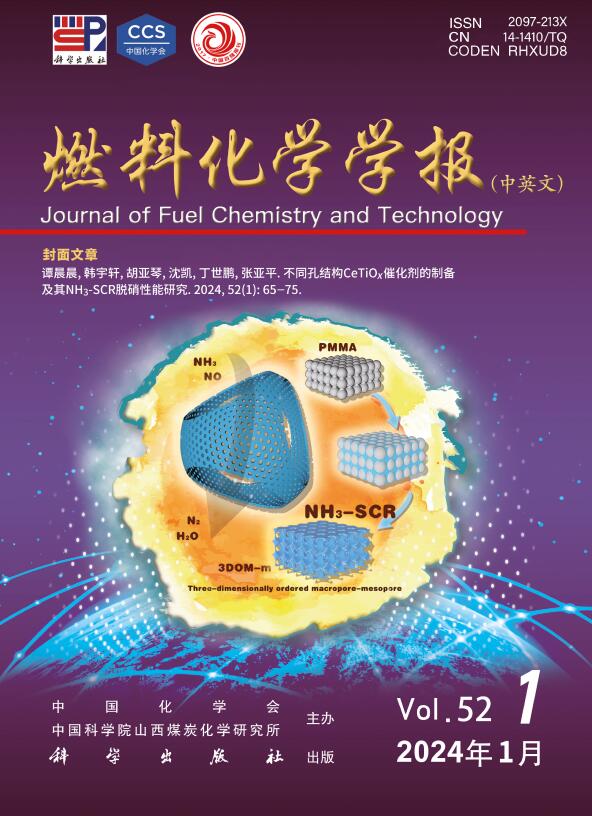Catalytic effects of simulated biomass ashes on coal gasification reactivity and the transformation evolution of minerals during gasification process
Q3 Energy
引用次数: 0
Abstract
The influence of key components in biomass ash on the gasification reactivity of coal, the migration patterns of typical biomass ash components and the structural evolution characteristics of coal during gasification process were deeply investigated by using a simulated biomass ash. The results indicate that gasification temperature and Si element content are the key factors affecting the gasification reactivity of coal. When the Si/K mass ratio is 0.5 and 1.0, the gasification reactivity of the composite coal sample is larger than that of raw coal, while the Si/K mass ratio is 1.5, the gasification reactivity is less than that of raw coal. Under the experimental conditions, the composite coal sample with a Si/K mass ratio of 0.5 and a Ca/K mass ratio of 0.4 shows the greatest reactivity. The gasification reactivity index is 1.35 times higher than that of raw coal. Compared to potassium-containing minerals, the calcium-containing minerals have stronger catalysis and are more likely to react with silicates to form calcium-containing silicates, such as calcium zeolites (CaO·Al2O3·2SiO2·4H2O), thereby avoiding the reaction between potassium-containing minerals and silicates to form non-catalytic minerals, which allows potassium to fully exert its catalytic effects. Dynamic analysis implies that the shrinking core model well describes the gasification process of deashing coal catalyzed by simulated biomass ash. When the Si/K mass ratio is 0.5 and the Ca/K mass ratio is 0.4, the gasification reaction activation energy of composite coal is reduced to 174.39 kJ/mol, which is 14.32% lower than that of raw coal.
模拟生物质灰烬对煤气化反应性的催化作用及气化过程中矿物的转化演化
通过模拟生物质灰分,深入研究了生物质灰分中关键组分对煤的气化反应性的影响、典型生物质灰分组分的迁移规律以及煤在气化过程中的结构演化特征。结果表明,气化温度和硅元素含量是影响煤气化反应性的关键因素。当Si/K质量比为0.5和1.0时,复合煤样品的气化反应活性大于原煤,而Si/K质量比为1.5时,气化反应活性小于原煤。在实验条件下,Si/K质量比为0.5、Ca/K质量比为0.4的复合煤样反应性最强。气化反应性指数比原煤高1.35倍。与含钾矿物相比,含钙矿物具有更强的催化作用,更容易与硅酸盐反应生成含钙硅酸盐,如钙沸石(CaO·Al2O3·2SiO2·4H2O),从而避免了含钾矿物与硅酸盐反应生成非催化矿物,从而使钾充分发挥其催化作用。动态分析表明,缩心模型较好地描述了模拟生物质灰催化脱灰煤的气化过程。当Si/K质量比为0.5、Ca/K质量比为0.4时,复合煤的气化反应活化能降至174.39 kJ/mol,比原煤低14.32%。
本文章由计算机程序翻译,如有差异,请以英文原文为准。
求助全文
约1分钟内获得全文
求助全文
来源期刊

燃料化学学报
Chemical Engineering-Chemical Engineering (all)
CiteScore
2.80
自引率
0.00%
发文量
5825
期刊介绍:
Journal of Fuel Chemistry and Technology (Ranliao Huaxue Xuebao) is a Chinese Academy of Sciences(CAS) journal started in 1956, sponsored by the Chinese Chemical Society and the Institute of Coal Chemistry, Chinese Academy of Sciences(CAS). The journal is published bimonthly by Science Press in China and widely distributed in about 20 countries. Journal of Fuel Chemistry and Technology publishes reports of both basic and applied research in the chemistry and chemical engineering of many energy sources, including that involved in the nature, processing and utilization of coal, petroleum, oil shale, natural gas, biomass and synfuels, as well as related subjects of increasing interest such as C1 chemistry, pollutions control and new catalytic materials. Types of publications include original research articles, short communications, research notes and reviews. Both domestic and international contributors are welcome. Manuscripts written in Chinese or English will be accepted. Additional English titles, abstracts and key words should be included in Chinese manuscripts. All manuscripts are subject to critical review by the editorial committee, which is composed of about 10 foreign and 50 Chinese experts in fuel science. Journal of Fuel Chemistry and Technology has been a source of primary research work in fuel chemistry as a Chinese core scientific periodical.
 求助内容:
求助内容: 应助结果提醒方式:
应助结果提醒方式:


